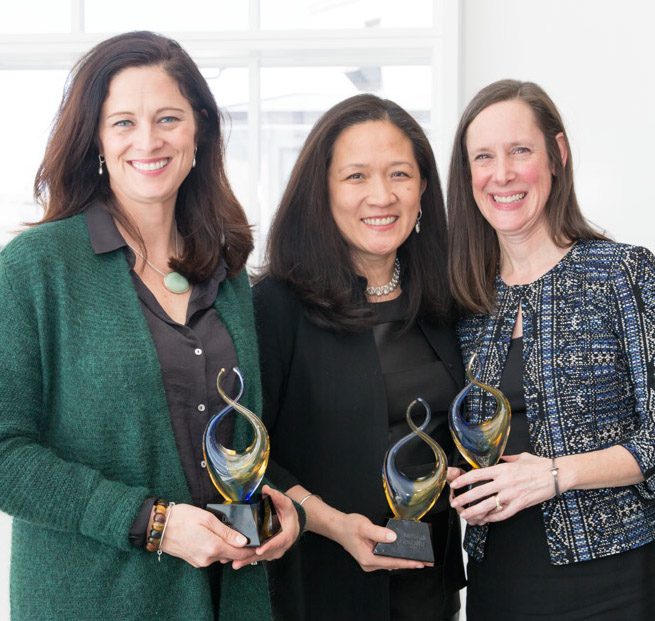The Diversity & Flexibility Alliance’s Spotlight on Flex showcases professionals from member organizations who exemplify personal and professional success while working a flexible schedule. Their stories illustrate the long-term benefits that flexible schedules offer to both individuals and organizations.
PAST SPOTLIGHTS
If you are a professional working a flexible schedule and would like to share your story in an upcoming Spotlight on Flex, please contact Angela Whitehead Quigley.


Spotlight on Flex – Jay Kugler DeYoung
Our Spotlight on Flex showcases professionals from member organizations who exemplify personal and professional success while working a flexible schedule. Their stories illustrate the long-term benefits that flexible schedules offer to both individuals and organizations.
For March 2019, we are pleased to share insights from Jay Kugler DeYoung, Principal, Fish & Richardson (Boston, MA).
Diversity & Flexibility Alliance: How have you made flexibility a priority and a success with your career? How has the firm supported this?
Jay Kugler DeYoung: Before I came to Fish & Richardson in 2002, I worked for two years at a general practice firm. I wanted to focus on biotechnology prosecution, and I was happy to move to Fish & Richardson when the opportunity presented itself. I joined Fish as a full time associate, and in 2008 I came up for partner – just as I had my first child. I made partner that year and came back on a reduced hours schedule after my daughter was born. I have an hour long commute each way, and I wanted to be home to see my child and eat dinner together as a family. I moved to an 80% reduced hours schedule that consisted of coming into the office each day from 9:30 am – 5:30 pm. I telecommuted as necessary too, and I’ve never looked back.
The firm has never pressured me to go back to full time, in fact, I believe the firm sees flexibility as a win/win for everyone. I chose to reduce my hours because I wanted be involved with firm activities around associate mentoring, training, evaluation, and advancement. Over the years, I’ve expanded my internal involvement to include partner evaluation and advancement too.
Spotlight on Flex – Andrea Brockway
Our Spotlight on Flex showcases professionals from member organizations who exemplify personal and professional success while working a flexible schedule. Their stories illustrate the long-term benefits that flexible schedules offer to both individuals and organizations.
For February 2019, we are pleased to share insights from Andrea Brockway, Counsel, Saul Ewing Arnstein & Lehr (Philadelphia, PA).
Diversity & Flexibility Alliance: How have you made flexibility a priority and a success with your career? How has the firm supported this?
Andrea Brockway: I started at the firm as a full-time litigation associate in 2008 after graduating from Temple Law School. In late 2010, I switched to a reduced hours schedule after the birth of my first child. The firm had a formal flex policy in place when I asked to reduce my hours, and my request was approved. Since switching to flex eight years ago, I’m now the proud mother of four children and have maintained a successful litigation practice representing clients in higher education and white collar criminal defense. The firm and my colleagues have always been supportive of my flexible work arrangement because they trust I’m going to complete the work and do it well.As a litigator, my work and deadlines vary day to day, but I try to block off Fridays to focus on my family. Even though the nature of litigation doesn’t always fit that schedule, my flex hours enable me to decline non-essential meetings scheduled on Fridays. My coworkers understand because they know I’ll always attend to my work commitments on time.
When it comes to flex, it’s not just the reduced hours, but it’s also the flexible work environment that’s been helpful for me. The firm has been very supportive of me working remotely where feasible.
Spotlight on Flex – Molly Senger
Our Spotlight on Flex showcases professionals from member organizations who exemplify personal and professional success while working a flexible schedule. Their stories illustrate the long-term benefits that flexible schedules offer to both individuals and organizations.
For January 2019, we are pleased to share insights from Molly Senger, Of Counsel, Gibson Dunn (Washington, DC).
Diversity & Flexibility Alliance: How have you made flexibility a priority and a success with your career? How has the firm supported this?
Molly Senger: I came to Gibson Dunn in 2011 as a third year associate after I completed a clerkship with the Honorable John D. Bates at the US District Court for the District of Columbia. I started full time, but after I had my son in January 2016, I came back from maternity leave to a 70% reduced hours schedule. The only formalized aspect of my flex schedule is my reduced hours target; what I’ve learned is you have to be flexible with your time and each day is different. I’m generally in the office every day, but my hours vary depending on what’s happening in the matters I’m working on at the time. I’ve had months in which I’ve had an arbitration and far exceeded full-time hours. But I’ve also had months in which my matters have been relatively quiet, and I’ve been able to take advantage of my flex schedule.
One thing I try to keep in mind with my flex schedule is something one of my mentors told me; “it’s unlikely you’ll find a perfect balance every day, but if you strive for it, you can find the balance you want over the long-term.” Once I started working flex, I made it a priority to be more comfortable saying “no.” I enjoy my work and give 110% to all my matters,